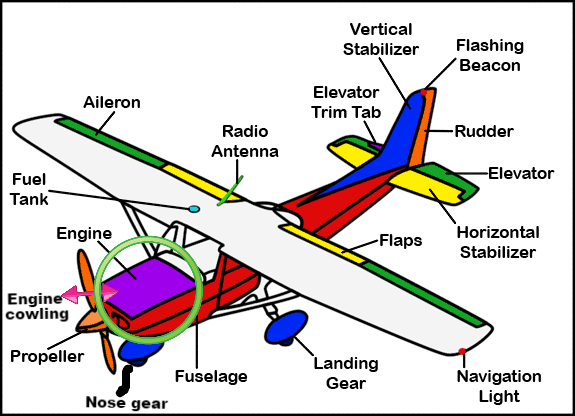

EnglisH AcademY
Online... ...




Vocabulary
-
Aircraft
-
APU
-
Circuit breaker
-
Cabin
-
Call light
-
Cockpit
-
Rear galley
-
Front galley
-
Toilet
-
Airstairs
-
jumpseat
-
interphone
-
de-icing
-
slats
-
flaps
-
Door
-
Door handle
-
Slide
-
Girt bar
-
Pressure






Aircraft parts (estructura de un avion)
-
Fuselaje-Fuselage... (fiuselach)
-
Alas- Wings... (huings)
-
Cola- Tail...(teil) Empenaje- Empennage...(empenach)
-
Motor- Engine...(enyin)
-
Tren de aterrizaje- Landing gear...(lænding guiiir)
Airfoil (perfil alar)
An airfoil-shaped body moved through a fluid produces an aerodynamic force.

Flight instruments are the instruments in the cockpit of an aircraft that provide the pilot with information about the flight situation of that aircraft, such as altitude, airspeed and direction.
There are six traditional flight instruments in most aircraft cockpits. Many of these instruments have taken on a more modern appearance over time, but even technologically advanced aircraft have traditional instruments to use as back-ups in case the primary system fails.
The following instruments make up what's called the "six-pack" in a traditional cockpit where three instruments are stacked on top of three more instruments.
These six basic flight instruments are the main source of cockpit flight information for pilots
Flight instruments

Airspeed Indicator: The airspeed indicator tells the pilot the indicated airspeed in knots (or in some cases, a Mach number).
Airspeed indicators are color coded so the pilot can easily identify ranges such as the normal operating range, flap-operating range, and caution range. Minimum and maximum speeds, as well as other important speeds (known as V-speeds) are marked as well.
Altimeter: The altimeter reflects the aircraft's vertical height above MSL (mean sea level) corrected for outside air pressure.
The altimeter works similar to a basic barometer, by comparing the static pressure inside of a sealed aneroid capsule to the expanding or contracting pressure surrounding it. When the airplane ascends or descends, the air pressure will decrease of increase, respectively. This outside air pressure is constantly being compared to the pressure inside the aneroid capsule, and with the help of linkage and a pointer, the altitude is displayed on the cockpit instrument.
Vertical Speed Indicator: Vertical speed is the rate of the aircraft's climb or descent, usually depicted in feet per minute (fpm) on the vertical speed indicator (VSI).
The VSI is valuable in determining if the airplane is climbing or descending and the rate of the climb or descend. There can be a slight lag in information depicted on the VSI if the aircraft is maneuvered abruptly. In turbulence, the indications can be slightly erratic.